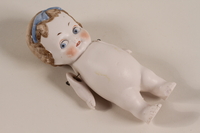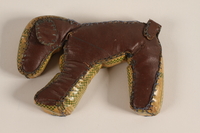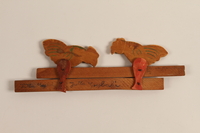Overview
- Brief Narrative
- Illustrated poetry book used by 9 year old Jutta Grybski (Janet Beasley) in the Theresienstadt ghetto/labor camp. The book was found by Jutta in the ghetto. She had brought an identical copy of the book with her to the camp when she was deported from Berlin, but then lost it. The book she found may be the same one that she lost. She wrote a note inside the book recounting this history. The cover illustration features a young girl who looks like very much like a bisque Kewpie style doll, 1996.76.1, that Jutta also brought with her to Theresienstadt. Jutta had a Jewish mother, Kaethe, and a Catholic father, Hans, who divorced in late 1938 in Berlin, Germany. Hans enlisted in the German Army. His Aryan status and military service would protect Jutta and Kaethe from deportation, although their lives were restricted by anti-Jewish legislation. Jutta could not attend school or use public parks. Kaethe was forced to work in a commercial laundry. Jutta’s maternal grandparents Jakob and Bianka were deported to concentration camps in 1942 and 1943. After Hans was killed in battle on October 9, 1944, Kaethe and Jutta were arrested, and, on October 27, deported to Theresienstadt in the German protectorate of Czechoslovakia. Kaethe worked night shifts in a mica factory. They were given insufficient rations so Jutta stole extra food when she could. The camp was liberated on May 9, and they returned to Berlin in mid-June. Jutta’s maternal grandparents and uncle perished in the Holocaust. Jutta and Kaethe left for the United States in 1946.
- Title
- Bunte Luftballons
- Date
-
publication/distribution:
1928
use: 1944-1945 May
- Geography
-
publication:
Berlin (Germany)
use: Theresienstadt (Concentration camp); Terezin (Ustecky kraj, Czech Republic)
- Credit Line
- United States Holocaust Memorial Museum Collection, Gift of Janet Beasley
- Contributor
-
Publisher:
Rudolf Mosse Buchverlag
Printer: Dr. Trenkler & Co.
Artist: Lottie Gorn
Poet: Ellinor
Subject: Janet I. Beasley
- Biography
-
Jutta Ina Grybski was born on November 30, 1935, in Berlin, Germany, to a Catholic father and Jewish mother, Hans and Kaethe Schrimmer Grybski. Hans was born on November 8, 1911, in the Rixdorf area of Berlin and had six siblings. Kaethe was born on April 29, 1911, in Berlin to Jakob (b. 1882) and Bianka Tann Schrimmer (b. 1885). Jakob was a merchant and served in the Germany Army in World War I. Kaethe had one older brother, Manfred. Hans and Kaethe were married in approximately 1933, causing tension with Hans’s family. Hans wanted to enlist in the German army, but was prevented from joining while married to a Jewish woman. Hans and Kaethe divorced in November 1938 and Hans then enlisted. Kaethe and Jutta moved into an apartment across the hall from Kaethe’s parents. Of Hans’s large family, only Jutta's grandmother Emma and two aunts would acknowledge Jutta. She had a cousin Lydia, daughter of Hans's brother Walter and his wife Lisbeth with whom she played at their grandmother's. Hans married again, to Frida Jahring, who was very kind to Jutta. Hans visited Jutta and Kaethe when he was home on leave.
The Nazi government, in power since 1933, actively persecuted the Jewish population. Jutta’s Jewish kindergarten was closed. She could not go to the park or use public transportation. Kaethe was forced to labor in a commercial laundry. Her mother Bianka watched Jutta, and taught her to read and write. In September 1939, World War II began when Germany invaded Poland. During air raids, Jutta and her family went to the basement instead of the shelter. They had to share their apartment with strangers. Their ration cards had J’s on them and they could not buy white bread, cakes, or sweets. They could only shop between 4 and 5 o’clock and not all stores served them. They had to give up their radio. Beginning in September 1941, they had to wear Star of David badges. Jutta sometimes covered her Star of David badge to ride public transportation alone and to go to the park with her grandmother Bianka. Jutta eventually feared going out because she was taunted by other children. Han's Aryan status and military service provided protection from deportation for Jutta and Kaethe, but as Jews they were outcasts from German society. In May 1942, Jutta’s maternal grandfather Jakob was taken away. Kaethe was frequently arrested at work or when she went to pick up their ration cards. At one point, she and Jutta were sent to a collection center, but when Kaethe showed the authorities a picture of Jutta with Hans in his army uniform, they were released. On March 3, 1943, Jutta’s grandmother Bianka was taken away. Jutta’s paternal grandmother Emma began to occasionally take care of her. Both Emma and Hans insisted that Jutta remove her Star of David badge when she was with them. Jutta and Kaethe were close with Hans’s nephew Werner Kurz, son of Hans's sister Erna, who visited them on leave from the German Army. He would go for walks with Jutta and insist that she keep her badge on, saying that he dared anyone to confront them.
In October 1944, Kaethe was arrested at work and brought home by two Jewish ordners, men who worked with the Gestapo to assist with deportations. They told Kaethe to pack a suitcase, then took Kaethe and Jutta to a collection center. After a couple days, Jutta was allowed to return to the apartment to gather more things. She took toys and her grandmother’s silver spoons. On October 26, the children were separated from their parents and taken to the train station. The next day, their parents joined them and they were deported to Theresienstadt ghetto-labor camp in Czechoslovakia. After arrival, they were put in a large room full of mattresses, then assigned to a garrison. Jutta and the other children would play hide and seek in the corridor and sometimes trip over dead bodies. A neighbor in Berlin sent Jutta and Kaethe a package of food with instant chocolate pudding, which Kaethe made for Jutta’s ninth birthday in November. Kaethe worked in the mica plant at night. They were given soup and rations but were malnourished and Jutta stole extra food when she could. In spring 1945, thousands of additional prisoners were brought into the camp. They had been in concentration camps and were afraid to go into the showers. Jutta, Kaethe, and other women assured them it was safe. Kaethe was reassigned to build new showers, which the inmates suspected were to be gas chambers. The Red Cross came in April, then took over the camp on May 2. The guards left. German soldiers were constantly moving on the road and they frequently shot into the camp, which made Jutta’s room by the road dangerous. On May 9, Soviet troops entered the camp.
Kaethe and Jutta returned to Berlin in the middle of June and stayed with Jutta’s paternal grandmother Emma. Her aunt Lisbeth told her that her father Hans had been killed in battle on the eastern front October 9, 1944, which was just before Jutta and Kaethe were arrested. He was a corporal in the Panzer-Grenadier Regiment 393. Her paternal cousin Werner had been sent home on medical leave for refusing to fight but was sent back to the frontlines and killed. Jutta's paternal grandfather Jakob was killed in Sachsenhausen on October 26, 1942. His official cause of death was dysentery, but they suspected he was shot. Her grandmother Bianka was killed upon arrival in Auschwitz-Birkenau. Her uncle Manfred was killed in 1943. In late 1945, Jutta was sent to a British rest home for Jewish children in Luneburg for six months. They were fed well and educated in English and Hebrew. On December 9, Jutta and Kaethe sailed on the SS Marine Marlin to America, arriving in New York on December 20. Jutta changed her name to Janet and Kaethe to Kate. They settled in New York. Kate got a job at a factory and Janet began school for the first time. She began working at age 16. Janet's first marriage ended in divorce and in 1979 she married Albert Beasley. Kate, age 82, died on May 29, 1993.
Physical Details
- Language
- German
- Classification
-
Books and Published Materials
- Category
-
Children's books
- Object Type
-
Books (lcsh)
- Physical Description
- [22 leaves] : col. ill. ; 35 cm.
Binding note: sewn, pub. yellow cloth, orange col. pict. bds.
The book is very worn and well used. It is inscribed on the flyleaf, and there are are scribbles and partial drawings on the title and back pages. It has a yellow cover with an illustration of a dog attached to a group of balloons and a young girl dressed in yellow dress and hat who resembles a kewpie doll. The book presents 34 illustrated poems on 17 unnumbered pages, some based on fables: title, illustration, poem, and uses fraktur text. - Materials
- overall : paper, ink, graphite, cloth, crayon
- Inscription
- front fly leaf, back, upper left edge, red crayon : Jutta Grybski
front, fly leaf, back, upper right edge, black pen : [Gúsf. L Sryf.?] 1930. / No 126
front fly leaf, back, upper left, pencil : Jutta Grybski / Dieses Buch / habe ich mit / ? Jahren verloren, / in Berlin Deutschland/und fand es wieder / im / Conzentrations- / camp Theresien / stadt wieder/ [SE?] 583800) [Jutta Grybski. I lost this book [when I was] ? years old in Berlin, Germany and found it again in the Theresienstadt concentration camp]
front fly leaf, back, upper right, pencil : konzentrations- camp / [Theresienstadt]. das selbe / ich erkannt es an der [Widmund] [concentration camp Theresienstadt -- the same -- I recognized it on the [?]]
front fly leaf, back, upper right, embossed : Library of Janet Beasley
Rights & Restrictions
- Conditions on Access
- No restrictions on access
- Conditions on Use
- No restrictions on use
Keywords & Subjects
Administrative Notes
- Legal Status
- Permanent Collection
- Provenance
- The book was donated to the United States Holocaust Memorial Museum in 1996 by Janet I. Beasley.
- Funding Note
- The cataloging of this artifact has been supported by a grant from the Conference on Jewish Material Claims Against Germany.
- Record last modified:
- 2022-09-14 15:15:15
- This page:
- https://collections.ushmm.org/search/catalog/irn11793
Download & Licensing
In-Person Research
- By Appointment
- Request 21 Days in Advance of Visit
- Plan a Research Visit
- Request to See This Object
Contact Us
Also in Janet Beasley collection
The collection consists of a bisque doll, a stuffed animal, a wooden toy, and a children's book relating to the experiences of Jutta Grybski (later Janet Beasley) before the Holocaust in Berlin, Germany, during the Holocaust in Theresienstadt ghetto-labor camp, and after the Holocaust near Terezin in Czechoslovakia.
Date: approximately 1935-1945

Small white tinted all bisque doll brought by a German Jewish girl to Theresienstadt
Object
Porcelain kewpie style doll brought by 8 year old Jutta Grybski to Theresienstadt ghetto labor-camp, where she was held from October 1944 to May 1945. The doll belonged to Jutta’s mother when she was a girl. Jutta had a Jewish mother, Kaethe, and a Catholic father, Hans, who divorced in late 1938 in Berlin, Germany. Hans enlisted in the German Army. His Aryan status and military service would protect Jutta and Kaethe from deportation, although their lives were restricted by anti-Jewish legislation. Jutta could not attend school or use public parks. Kaethe was forced to work in a commercial laundry. Jutta’s maternal grandparents Jakob and Bianka were deported to concentration camps in 1942 and 1943. After Hans was killed in battle on October 9, 1944, Kaethe and Jutta were arrested, and, on October 27, deported to Theresienstadt in the German protectorate of Czechoslovakia. Kaethe worked night shifts in a mica factory. They were given insufficient rations so Jutta stole extra food when she could. The camp was liberated on May 9, and they returned to Berlin in mid-June. Jutta’s maternal grandparents and uncle perished in the Holocaust. Jutta and Kaethe left for the United States in 1946.

Small handsewn stuffed brown and yellow dog brought by a German Jewish girl to Theresienstadt
Object
Small stuffed dog brought by 8 year old Jutta Grybski to Theresienstadt ghetto labor-camp, where she was held from October 1944 to May 1945. It was given to Jutta by her maternal grandmother. Jutta had a Jewish mother, Kaethe, and a Catholic father, Hans, who divorced in late 1938 in Berlin, Germany. Hans enlisted in the German Army. His Aryan status and military service would protect Jutta and Kaethe from deportation, although their lives were restricted by anti-Jewish legislation. Jutta could not attend school or use public parks. Kaethe was forced to work in a commercial laundry. Jutta’s maternal grandparents Jakob and Bianka were deported to concentration camps in 1942 and 1943. After Hans was killed in battle on October 9, 1944, Kaethe and Jutta were arrested, and, on October 27, deported to Theresienstadt in the German protectorate of Czechoslovakia. Kaethe worked night shifts in a mica factory. They were given insufficient rations so Jutta stole extra food when she could. The camp was liberated on May 9, and they returned to Berlin in mid-June. Jutta’s maternal grandparents and uncle perished in the Holocaust. Jutta and Kaethe left for the United States in 1946.

Handmade, moveable, wooden chicken toy purchased for a German Jewish girl after her liberation from Theresienstadt
Object
Moveable wooden toy given to 9 year old Jutta Grybski after her liberation from Theresienstadt ghetto in May 1945. Soon after Soviet forces liberated the camp on May 9, a friend, Siegbert Einstein, who had also been a prisoner, went to the nearby town of Litomerice and brought the toy back for Jutta. Jutta had a Jewish mother, Kaethe, and a Catholic father, Hans, who divorced in late 1938 in Berlin, Germany. Hans enlisted in the German Army. His Aryan status and military service would protect Jutta and Kaethe from deportation, although their lives were restricted by anti-Jewish legislation. Jutta could not attend school or use public parks. Kaethe was forced to work in a commercial laundry. Jutta’s maternal grandparents Jakob and Bianka were deported to concentration camps in 1942 and 1943. After Hans was killed in battle on October 9, 1944, Kaethe and Jutta were arrested, and, on October 27, deported to Theresienstadt in the German protectorate of Czechoslovakia. Kaethe worked night shifts in a mica factory. They were given insufficient rations so Jutta stole extra food when she could. The camp was liberated on May 9, and they returned to Berlin in mid-June. Jutta’s maternal grandparents and uncle perished in the Holocaust. Jutta and Kaethe left for the United States in 1946.



